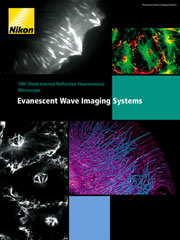Nikon Laser TIRF System
Nikon Updated: 2007-06-19Enables the visualization of single molecule activity in living cells.
Nikon's Laser TIRF is a turnkey evanescent wave imaging system that's so user friendly, it's as simple to use as a standard fluorescence microscope. The evanescent wave resulting from total internal reflection (TIR) causes excitation of fluorescent molecules in an optical section, typically less than 100nm, without exciting molecules throughout the specimen. Evanescent wave illumination provides such high signal to noise (S/N) ratios that it is possible to observe single molecule activity in living cells where they are in contact with the coverglass.
Integration into Epi-fluorescence System
The newly developed laser TIRF-2 system combines a laser TIRF system and epi-fluorescence system in a single unit. Researchers can observe the same field of view using both the TIRF and epi-fluorescence methods by simply shuttering light sources. Alignment is also extremely easy.
Ultra-high Signal/noise Ratio Enables Observations of Single Molecules
The extremely high S/N ratio created by Nikon’s laser TIRF imaging system makes it possible to observe single molecules. Thanks to Nikon’s proprietary Noise Terminator mechanism, the system can also produce breathtaking epi-fluorescence images with a high S/N ratio.
Specimen: YFP-tagged neurotransmitter receptors expressed in dispersed hippocampal neurons in primary culture
Images courtesy of Dr. Chieko Nakada, Kyoto University, Co-researcher Professor Shigeo Okabe, Tokyo Medical and Dental University
Extendable
The modular extendable structure of the TE200 inverted microscope facilitates integration of Laser TIRF with either standard epi-fluorescence or the high performance W-TIRF, “white light” TIRF and oblique illuminator, still leaving space for integration of the “perfect focus system” or additional imaging modality.
Multi-mode Imaging Observation
Integration of TIRF with laser scanning confocal is a powerful combination of modalities, which enables the study of dynamic events at the cell membrane, in addition to 3D imaging with extremely high signal-to-noise deep within cells or tissues.
TIRF-C1 Confocal Configuration
The TIRF-C1 system allows multimode imaging with laser TIRF, confocal and epi-fluorescence. This configuration can be a powerful tool for research, allowing the investigation of an event at the cell membrane, and the ability to follow the subsequent event cascade deep into the cells interior.
Evanescent Wave Illumination
Nikon’s high NA TIRF objectives make it possible to introduce laser illumination at incident angles greater than the critical angle (θc) resulting in TIRF that creates an evanescent wave immediately adjacent to the coverglass-specimen interface. The evanescent wave reaches maximally a few hundred nanometers into the specimen and its energy drops off exponentially.
Nikon’s laser TIRF system utilizes this evanescent wave to excite single molecules in the thin section in contact with the coverglass. Because the specimen is not excited beyond the evanescent wave, this imaging system can produce fluorescence images with an extremely high signal-to-noise (S/N) ratio.
CFI Plan Apochromat TIRF Objectives
These objectives are the world’s first oil-immersion-type objectives to incorporate a correction ring for temperature changes and coverglass thickness. By rotating its correction collar, researchers can easily eliminate spherical aberrations’ negative influence on the image quality resulting from temperature-induced changes in the refractive index of the immersion oil and influence from variation in the coverglass thickness. The lenses have been calibrated for a range from 23°C (room temperature) to 37°C (physiological temperature). Additionally, these objectives also provide spectacular images under DIC, epi-fluorescence, confocal, and deconvolution imaging, while providing a strong trapping power during applications using laser tweezers.
SRIC (Surface Reflective Interference Contrast) Method Can Reveal Focal Contracts Prior to Switching to TIRF
As evanescent wave illumination excites within approximately 100 nm from the glass surface, TIRF observations require that specimens contact the coverglass, otherwise no TIRF image is obtained. SRIC makes all sections in contact with glass appear black, allowing users to confirm whether a specimen has adhered to the glass before proceeding with TIRF observation. As no excitation light is used in this process, specimen damage is minimized and users can take their time focusing.
Nikon has developed an SRIC system that can be used with both the laser TIRF-2 and white-light TIRF systems. Using SRIC is as simple as switching to the special filter cube.
Laser TIRF System
Related Manuals
Nikon NT88-V3 Micromanipulator Systems
Nikon Eclipse 55i Biological Microscope
Nikon Eclipse TE2000-PFS Inverted Research Microscope With Real-Time Focus Correction
Nikon Eclipse TS100/TS100F Inverted Routine Microscope
Nikon BioStation IM Live Cell Recorder
Nikon Eclipse TE2000 Inverted Research Microscope Systems
Nikon Eclipse FN1 Fixed Stage Microscope for Electrophysiological Research
Nikon Eclipse E200 Biological Microscope
Nikon Eclipse E100 Biological Microscope
Nikon Eclipse 80i Advanced Research Microscope
Nikon COOLSCOPE Digital Microscope
Nikon Eclipse 90i Advanced Automated Research Microscope System
